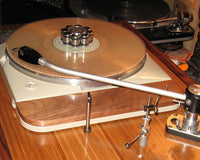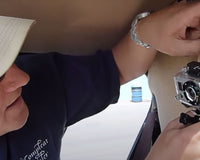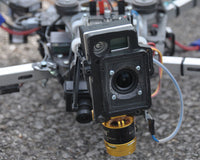I'm one of the 150 million Americans who love their coffee in the morning and I also despise the noise of my loud little electric coffee grinder. For years, I've cringed and accepted that its high-pitched wail is just a normal part of unlocking the wonderful flavor trapped in my favorite coffee beans. However, here at Isolate IT we stive to bring you affordable peace and quiet, and today, a more relaxing cup of coffee.
In this post of Making Things Quiet, I'm focusing on the humble and simple electric coffee grinder. There are lots of models out there with prices that range significantly. If you like grinding your coffee by hand, then maybe this article isn't for you. For the rest of us, let's dive into a simple project that will quickly and easily make whatever coffee grinder you own or will soon own much quieter by a factor of 10 (10dB). 
I'll also note that there are things called "Silent Coffee Grinders" and they are not silent. They may be closer to the ambient noise in your kitchen, but no one has mastered the physics defying trick of creating a true silent grinder. The noise emitted by these little kitchen appliances varies depending on their power, the internal isolation of the electric motor, and the design of the grinder housing. There's another factor to consider. That is the resonance of your kitchen counter.
The noise that we hear from a coffee grinder (or blender, food processor, mixer, etc.) comes both directly from the appliance and through vibration transferred to the countertop that then resonates into the air. Depending on the appliance and the countertop material, this resonance can account for a significant portion of the annoyingly loud noise of these kitchen appliances. In our tests we saw 5 Decibel (dB) higher readings on lighter weight counters like wood and laminate compared to quartz and stone. Once the vibration energy from the motor of your coffee grinder makes its way into the countertop, it is going to be emitted as sound. If we can reduce the amount of this energy that reaches the counter, then we can also reduce how loud or audible the coffee grinder is.
Coffee grinder manufactures know this, and many include some type of rubber feet on the bottom of the grinder and some then some try to save a few more cents and don't. Usually, the stock feet on your grinder are made of cheap dense rubber and while that makes them fairly durable and non-skid, it leaves lots of room for improvement. That's where I see opportunity for a quick upgrade to Isolate IT Sorbothane Hemispheres. These Sorbothane hemispheres range in size but for a coffee grinder, 1/2" - 1" diameter is usually the best range to stick with.
For the purposes of this build we don't really care about weight loading. That's because most grinders require some amount of downward pressure to activate. This introduces too much variability to accurately tune weight loading. Instead, we'll focus on the soft and damping properties of 30 (soft) and 50 (medium soft) durometer Sorbothane. I also decided to test our classic urethane bumpons to give us additional data. In these tests, the thicker the layer of Sorbothane, the more isolation we will see. Since most coffee grinders are round, 3 pads or feet equally spaced around the perimeter of the base will give us the most stable build.
I'm using a basic Capresso 100W electric coffee grinder for this test because it is inexpensive and the value of using our Isolate IT Sorbothane is that you can often save money by buying a lower-end appliance and upgrading it rather than paying for a premium one. Plus, if you get a premium "silent grinder" like the Krups Silent Vortex then you'll get a layered improvement for an even quieter home.
To give a good control for this build test, I ran the coffee grinder as it comes, stock without any rubber feet. In this test the plastic base sat directly on a quartz counter. For all of these tests I also ran the grinder without coffee beans to take out that acoustic variability. We're trying to isolate the consistent motor whine, not the inconsistent noise of crushing the beans (that will be a different project). This stock setup gave readings of 75-80dB.

Next, I stuck 3 of our 12.7mm Isolate IT Sound Deadening Bumpers on the bottom of the coffee maker. The contoured shape of these combined with a softer clear urethane are an improvement over the stock rubber feet found on most appliances. They are also inexpensive and durable. Testing this setup, the acoustic noise range dropped to 73-78dB. That's nice, but we can do much better. Bring on the Isolate IT Sorbothane!

I tested 3 different versions of the Isolate IT Sorbothane Hemispheres. This product line is my favorite for these types of projects because they are versatile and easy to install. It's handy to have a few packs around my workshop for all kinds of quick fixes and quiet upgrades. For a low profile test, I stuck 3 of the 50 duro (medium soft) 1/2" diameter Sorbothane Hemispheres on the grinder. These gave just enough clearance to keep the base of the grinder from touching the counter top when I pressed down the grinder switch. This setup gave readings of 70-76dB or a reduction of 4-5dB over the stock setup.

In this case more Sorbothane is better, so let's crank it up a notch, or an 1/8" to be exact. By stepping up to a 3/4" Sorbothane Hemisphere and decreasing the durometer (softness) to 30, we can create a better isolation layer between the coffee grinder and the countertop. The softer Sorbothane is better at absorbing vibration in light duty applications like this. However, it's also very sticky and will attract dust (which is easily cleaned off with water). This setup saw the noise levels reduced even further to 69-74dB.

Lastly, and what I recommend for the best noise reduction on your coffee grinder is the 50 Duro (medium softness) 1" Sorbothane Hemisphere with urethane coating. These will only add 1/2" to the height of your coffee grinder plus the urethane coating keeps them clean and protected in the kitchen environment. They also offer a satisfying cushion under your coffee grinder plus they are non-skid and safe on all surfaces. Adding 3 of these Sorbothane hemispheres to the grinder reduced the noise range to 68-72dB. That's an improvement of around 10dB compared to the stock setup. Just for reference, the ambient noise in our test kitchen was 30-35dB.

In summary, creating a vibration isolation layer under your coffee grinder is a quick, affordable, and easy way to better enjoy your fresh cup of coffee in the morning without waking the whole house. Let me know your thoughts. What model coffee grinder did you install our Isolate IT Sorbothane Hemispheres on?
| Isolator | Quartz Countertop | Laminate Countertop |
| None (Stock) | 75-80dB | 79-84dB |
| Clear Bumpon | 73-78dB | 77-82dB |
| 1/2" Sorbothane Hemisphere (50 Duro) | 70-76dB | 73-79dB |
| 3/4" Sorbothane Hemisphere (30 Duro) | 69-74dB | 72-77dB |
| 1" Sorbothane Hemisphere (50 Duro, Urethane Coated) | 68-72dB | 70-74dB |
Also, this project is best enjoyed with a fresh cup of coffee. You may have noticed my favorite Cloudware mug in the photos. It was crafted by our neighbors at Haand Pottery in Burlington, NC.










